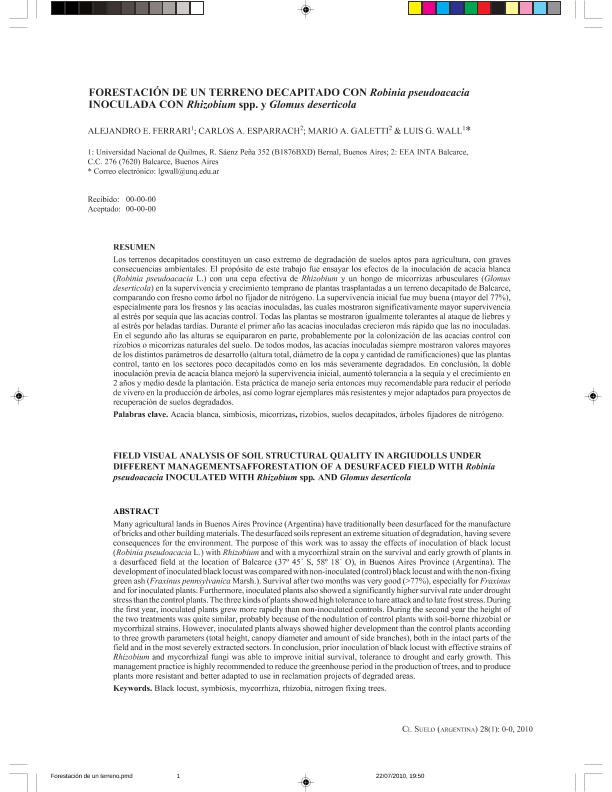Mostrar el registro sencillo del ítem
dc.contributor.author
Ferrari, Alejandro Eugenio

dc.contributor.author
Esparrach, Carlos A.
dc.contributor.author
Galetti, Mario A.
dc.contributor.author
Wall, Luis Gabriel

dc.date.available
2023-03-22T12:40:20Z
dc.date.issued
2010-12
dc.identifier.citation
Ferrari, Alejandro Eugenio; Esparrach, Carlos A.; Galetti, Mario A.; Wall, Luis Gabriel; Forestación de un terreno decapitado con Robinia pseudoacacia inoculada con Rhizobium spp. y Glomus deserticola; Asociación Argentina de la Ciencia del Suelo; Ciencia del Suelo; 28; 12-2010; 51-59
dc.identifier.issn
0326-3169
dc.identifier.uri
http://hdl.handle.net/11336/191364
dc.description.abstract
Los terrenos decapitados constituyen un caso extremo de degradación de suelos aptos para agricultura, con graves consecuencias ambientales. El propósito de este trabajo fue ensayar los efectos de la inoculación de acacia blanca (Robinia pseudoacacia L.) con una cepa efectiva de Rhizobium y un hongo de micorrizas arbusculares (Glomus deserticola) en la supervivencia y crecimiento temprano de plantas trasplantadas a un terreno decapitado de Balcarce, comparando con fresno como árbol no fijador de nitrógeno. La supervivencia inicial fue muy buena (mayor del 77%), especialmente para los fresnos y las acacias inoculadas, las cuales mostraron significativamente mayor supervivencia al estrés por sequía que las acacias control. Todas las plantas se mostraron igualmente tolerantes al ataque de liebres y al estrés por heladas tardías. Durante el primer año las acacias inoculadas crecieron más rápido que las no inoculadas. En el segundo año las alturas se equipararon en parte, probablemente por la colonización de las acacias control con rizobios o micorrizas naturales del suelo. De todos modos las acacias inoculadas siempre mostraron valores mayores de los distintos parámetros de desarrollo (altura total, diámetro de la copa y cantidad de ramificaciones) que las plantas control, tanto en los sectores poco decapitados como en los más severamente degradados. En conclusión, la doble inoculación previa de acacia blanca mejoró la supervivencia inicial, aumentó tolerancia a la sequía y el crecimiento en 2 años y medio desde la plantación. Esta práctica de manejo seria entonces muy recomendable para reducir el periodo de vivero en la producción de árboles, así como lograr ejemplares más resistentes y mejor adaptados para proyectos de recuperación de suelos degradados.
dc.description.abstract
Many agricultural lands in Buenos Aires Province (Argentina) have traditionally been desurfaced for the manufacture of bricks and other building materials. The desurfaced soils represent an extreme situation of degradation, having severe consequences for the environment. The purpose of this work was to assay the effects of inoculation of black locust (Robinia pseudoacacia L.) with Rhizobium and with a mycorrhizal strain on the survival and early growth of plants in a desurfaced field at the location of Balcarce (37º 45´ S, 58º 18´ O), in Buenos Aires Province (Argentina). The development of inoculated black locust was compared with non-inoculated (control) black locust and with the non-fixing green ash (Fraxinus pennsylvanica Marsh.). Survival after two months was very good (>77%), especially for Fraxinus and for inoculated plants. Furthermore, inoculated plants also showed a significantly higher survival rate under drought stress than the control plants. The three kinds of plants showed high tolerance to hare attack and to late frost stress. During the first year, inoculated plants grew more rapidly than non-inoculated controls. During the second year the height of the two treatments was quite similar, probably because of the nodulation of control plants with soil-borne rhizobial or mycorrhizal strains. However, inoculated plants always showed higher development than the control plants according to three growth parameters (total height, canopy diameter and amount of side branches), both in the intact parts of the field and in the most severely extracted sectors. In conclusion, prior inoculation of black locust with effective strains of Rhizobium and mycorrhizal fungi was able to improve initial survival, tolerance to drought and early growth. This management practice is highly recommended to reduce the greenhouse period in the production of trees, and to produce plants more resistant and better adapted to use in reclamation projects of degraded areas.
dc.format
application/pdf
dc.language.iso
spa
dc.publisher
Asociación Argentina de la Ciencia del Suelo

dc.rights
info:eu-repo/semantics/openAccess
dc.rights.uri
https://creativecommons.org/licenses/by-nc/2.5/ar/
dc.subject
Nitrogen Fixing Trees
dc.subject
Plant-Microbe Interactions
dc.subject
symbiosis
dc.subject
Soil Remediation
dc.subject.classification
Ciencias de las Plantas, Botánica

dc.subject.classification
Ciencias Biológicas

dc.subject.classification
CIENCIAS NATURALES Y EXACTAS

dc.title
Forestación de un terreno decapitado con Robinia pseudoacacia inoculada con Rhizobium spp. y Glomus deserticola
dc.type
info:eu-repo/semantics/article
dc.type
info:ar-repo/semantics/artículo
dc.type
info:eu-repo/semantics/publishedVersion
dc.date.updated
2023-03-21T18:18:01Z
dc.journal.volume
28
dc.journal.pagination
51-59
dc.journal.pais
Argentina

dc.journal.ciudad
Buenos Aires
dc.description.fil
Fil: Ferrari, Alejandro Eugenio. Universidad Nacional de Quilmes; Argentina
dc.description.fil
Fil: Esparrach, Carlos A.. Universidad Nacional de Quilmes; Argentina
dc.description.fil
Fil: Galetti, Mario A.. Universidad Nacional de Quilmes; Argentina
dc.description.fil
Fil: Wall, Luis Gabriel. Universidad Nacional de Quilmes; Argentina. Consejo Nacional de Investigaciones Científicas y Técnicas; Argentina
dc.journal.title
Ciencia del Suelo

dc.relation.alternativeid
info:eu-repo/semantics/altIdentifier/url/http://www.scielo.org.ar/scielo.php?script=sci_arttext&pid=S1850-20672010000100011
Archivos asociados
